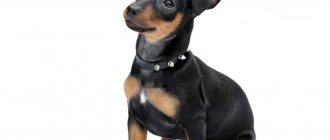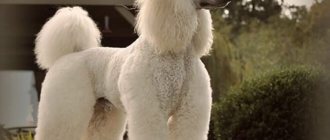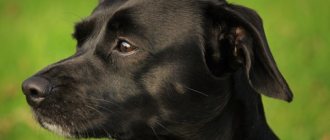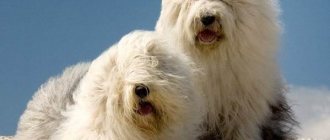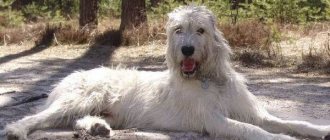Home » Dog Breeds
Classification Origin: Germany, France
Class: according to the ICF classification group 9, section 2
Sphere: pet
Color: black, white, brown, gray, apricot
Dimensions: height at withers: males - from 28 to 38 cm; knots – 28-35 cm; weight: males - 7-8 kg; knots – 4-6 kg
Lifespan: 10 to 15 years
The dwarf poodle will be a full-fledged pet, as it is a playful, intelligent and obedient dog with an easy-going character and good-natured disposition.
The Poodle, like the Schipperke and Petit Brabançon , is a wonderful companion for a child and a faithful, loving friend for adults.
Miniature Poodle loves to play with rubber toys
- 2 Psychology
- 3 Application
- 4 How to choose a dog
- 5 Features of care
5.1 Combing
- 5.2 Power
- 6.1 Characteristic diseases
History of the origin of the breed
The first mention of the poodle dates back to 1743. The original purpose of the dog was to hunt ducks and other waterfowl, when the animal was supposed to bring shot or wounded prey to its owner. The breed quickly spread in Europe. From France, the dogs came to Germany, where they also began to be bred as hunters' assistants, pulling birds out of the water.
The dog's modern name comes from the German expression "pudel-nass", which translates as "soaked to the skin." Thus, the breed cannot be considered exclusively French. Poodles, before they acquired their modern appearance, were improved not only by breeders from France, but also from Germany.
The dwarf variety of poodle, defined as a separate breed in its own right, was registered in France in 1936. Work on its breeding began in 1840. The result of selection, the purpose of which was to obtain a small-sized dog for convenient keeping in the city and small apartments, was successful. The main emphasis was also placed on the decorative nature of the animal. Thanks to this, dogs of small weight and height were obtained that have a special charm. The ancestor of all the small varieties of the breed that are popular today - the toy, small and dwarf poodle - was the classic hunting working variety, which has a fairly large size.
Interesting! Dogs with a poodle-like appearance have been depicted on Roman tombs dating back to the 30s BC.
During World War II, interest in toy poodles in Europe almost completely died out, and the breed survived only thanks to the enthusiasm of individual fanciers, as well as breeders on other continents. She became in demand again in the 60s, and from that time on, her active breeding began.
What is the difference between a toy poodle and a miniature poodle?
The main difference between a toy poodle and a toy poodle is height. The height of the first is 24–28 cm, the second is 28–35 cm. Another difference that is noticeable only to experts is the degree of expression of the occipital protuberance. In a toy poodle it may be slightly different - a little less noticeable.
However, other signs of dwarfism (sharp stop, spherical skull, snub muzzle) are excluded. Otherwise, the dogs are small copies of their larger counterparts, have the same proportions and are judged to the same standard.
Description of the Miniature Poodle breed with photos
The breed standard, by which the dog is still assessed, has been established since 1936. It was approved on the basis of the French line of the miniature poodle, which surpassed the German one in its decorative characteristics.
When creating the breed, the body proportions of the large working variety were preserved. The dog does not have the excessive skeletal delicacy of small breeds and, while remaining compact, appears strong and robust
- Head. Regular shape with a smooth transition from forehead to nose. The occipital protuberance is moderately expressed. The groove from it to the back of the nose can be clearly felt, even if it is poorly defined externally. The jaws are well developed and sufficiently strong for a dog of this size. When assessing the silhouette of the muzzle at exhibitions, they use not the lower edge of the jaw, but the edge of the lips.
- Lips. They have a medium size. Their corners are neat. Lips can be colored fur or black. Both options comply with the standard. The presence of pink spots on the lip folds is acceptable.
- Teeth. White, smooth. The row is full. Scissor bite.
- Nose. The nose is of medium size, black or the same color as the fur. The nostrils are widened.
- Eyes. They have a medium size. The inner corners are slightly pubescent. The color of the iris is brown (almost black) or amber. It depends on the color of the dog.
- Ears. Hanging, close to the head. They have an elongated shape. They are thick and moderately soft. Without taking into account the length of the fur of elite individuals, they should reach the corners of the mouth. Shorter ones are not considered a defect, but exhibition points will be reduced.
- Frame. Strong, shaped like a rectangle, which is slightly elongated. The back is short, tapering towards the croup. The loin is slightly raised and strong. The croup is rounded. The chest is oval, fairly wide, descending to the level of the elbow joints. The belly is tucked up, which gives the dog a sporty appearance.
- Paws. Straight, strong. The hock joints of the hind legs are set vertically. The thighs have pronounced muscles. The paw is collected tightly. There is a connecting membrane between the fingers.
- Tail. The setting is high. The modern standard allows for the preservation of the natural tail or its docking equally. When moving, the dog holds it high. There should be no curling of the tail.
The general external standards of the breed are the same for dogs of all colors. Deviation from them slightly reduces exhibition performance. An animal with significant defects is discarded, and its further breeding is highly discouraged.
Size and weight
The weight of a dog varies quite widely and can range from 4 to 6 kg . Height at the withers is from 28 to 35 cm . Bitches are always smaller than males. Dogs with smaller indicators are classified as toy poodles, while larger ones are classified as medium. When buying a puppy, it is advisable to see its parents: the size of the adult dog will help you understand whether the proposed baby really belongs to the miniature poodle breed. The average poodle, which is often sold as a toy, weighs more and is noticeably higher at the withers.
Color and coat type
Two types of coat of a miniature poodle are allowed - corded and curly. The first type of wool is denser and more massive. It is also heavier than curly due to thicker hair. The corded poodle's coat looks like thin braids, the length of which should be at least 20 cm. Curly dogs have a lighter and fluffier coat that looks voluminous. Both varieties of miniature poodles are clipped.
Most poodles have the usual one-color coat color:
- black;
- white;
- apricot (red);
- brown (sometimes called red or chocolate);
- silver (gray).
Since 2007, the FCI has also approved the standards for the red-brown color. At the same time, the colors harlequin (a combination of white and black) and with tan were recognized in Russia. The cost of such dogs is slightly higher than those of the same color, due to the small number of dogs. Not all lovers of the breed have a positive attitude towards the recognition of new colors, considering this to be a destruction of the established classic image of the poodle.
Historical reference
The Miniature Poodle dog is an “adapted” apartment version. The history of curly-haired four-legged animals, suspiciously similar to Poodles, stretches back to ancient Greece. There is only one nuance, there is no written confirmation of this fact, there are only drawings. Experts are not inclined to interpret the frescoes as evidence, since the captured image of four-legged animals can be “adjusted” to other breeds.
Historically confirmed facts tie the breed to France. By the way, French breeders invested the most in the development of Poodles and it is their standard that is accepted today by the FCI (Federation Cynologique Internationale). However, the roles of other countries should not be omitted. Great Britain has long been a trendsetter in canine fashion, and thanks to English breeders, the breed has spread throughout Europe. Taking up the baton, the Germans also began breeding Poodles.
Today, the breed is usually perceived as decorative, although this is not entirely fair. Four-legged animals are highly trained and have the right to claim the title of generalists. Poodles have demonstrated their flexibility during wars and in modern life. The Middle Poodle, which gave rise to other species, was actively used in duck hunting throughout Europe. Having no undercoat, no smell, and being very clean, the dog became a favorite in the homes of the nobility.
The purpose of breeding the Miniature Poodle is shrouded in fog. Experts tend to think that the incentive was the fashion for boudoir dogs. The next step on the path to the goal was the Toy Poodle, the smallest representative of the breed. Despite their size, dwarf dogs have well-developed working skills; breeders have always paid special attention to this nuance.
It is worth noting that the breed went through multi-stage selection, but retained its appearance and life expectancy. Poodles remained indifferent to their hairstyles, mastered the duties entrusted to them with great success and always kept up with progress.
It is unknown in what form the early ancestors of Poodles were represented, but the fact of multifaceted selection is undeniable. The blood of hunting, herding and service dogs was safely introduced into the gene pool of the breed. After such experiments, new breeds appeared, although their goal was to improve the fishing skills of the “curly ones.” It is reliably known that “water” dogs took part in the selection. The evidence is provided by the membranes between the Poodle's toes.
It should be noted that dogs of different sizes were noted in history even before the advent of gradation by height. For example, Henry IV kept a tall, brave Poodle, which would now be classified as a royal one. During the same period, in France and England, more compact, but no less powerful four-legged animals - medium Poodles - were actively used for hunting. From the same century, small sofa dogs with curly hair were noted; perhaps these were early dwarf representatives of the breed. Toy poodles are considered the youngest, as they were obtained through a simple selection of the smallest individuals among dwarf dogs.
Be that as it may, already in the first standard, published in 1868, all four varieties appeared. In addition, the British included a separate “item” in the description of the breed – the Harlequin Poodle (black and white). In 1904 the dogs were recognized in Germany, but the harlequin was not included in the standard. And finally, the rights to the breed were “won” by its homeland, France (1963). The official description was translated verbatim into English and accepted by the Fédération Cynologique Internationale.
The Poodle entered the ranks of Russian cynology gently and harmoniously. The previously exported dogs looked familiar, and the livestock, although not entirely purebred, was actively increasing. By 1886, a breed club was founded in Russia, devoting its resources to controlling breeding activities. By the way, initially, as if playing it safe, the union of cynologists was called vaguely - the Club of Pedigree Dog Lovers. Three years later, the organization was renamed the Poodle Club, and after the worldwide recognition of its wards, it was proclaimed national and all-Union.
This is interesting! The white dwarf poodle competed with pigs in their unusual trade! Dogs are (and have been) used to find truffles with great success. In such work, preference is given to individuals with white fur, because it is easier to see it in the dark.
Variety
Poodles are divided into varieties based on height and weight. This also determines the purpose of the dog. Thus, large and medium poodles belong to the category of service and sports dogs. Dwarf and toy poodles are exclusively decorative.
When choosing which type of poodle to purchase, you should strictly consider whether there is an opportunity for long walks and sufficient space in the apartment. Small dogs are most convenient in city conditions. For a large poodle, keeping it in a country house is optimal.
Important! The characterization of the dwarf poodle breed as a decorative one is not accidental, and it is impossible to breed it as a smaller copy of a sporting one for the same purposes.
Care for eyes, teeth, claws
- Wipe your eyes daily with cotton pads soaked in tea leaves or herbal infusion. If your dog begins to tear excessively, his eyes turn sour or turn red, this is a reason to contact a veterinarian for help.
- The process of caring for a miniature poodle involves regular brushing of teeth with special toothpastes for dogs or by a veterinary dentist.
- The dog's nails need to be trimmed every two or three weeks; after cutting, they are treated with a nail file.
Health and illness
Miniature poodles cannot be called very strong. Representatives of the breed get sick quite often, even with proper care. The root of health problems is the pursuit of breeders for the quality of the animal’s exterior. As a result, if an individual passes the external parameters, it is released for sale or further reproduction, regardless of whether it is in sufficiently good health. This problem occurs when breeding any ornamental breeds.
- Eye diseases. They are hereditary and occur in dogs of different ages. Poodles' eyes are the most vulnerable organ. The dog may be diagnosed with cataracts, glaucoma, and retinal degeneration. Most representatives of the breed experience problems of poor vision or even complete blindness in old age.
- Hip dysplasia. It occurs more often in dogs over 10 years of age. At a young age, it appears only with a pronounced hereditary predisposition to the disease, when both parents suffer from it.
- Osteochondrosis. The problem is common in dogs that are older or have had spinal injuries.
- Shift of the vertebral discs. Its main cause is back injuries, which active dogs can easily get while jumping from a great height or playing excessively with a child.
- Disorders of the thyroid gland. A hereditary disease that appears at any age, while the dog experiences obesity and disturbances in the digestive processes.
- Enlarged lymph nodes. The condition develops due to stress and can develop into cancerous lesions.
- Diabetes. It can appear at any age due to improper feeding or genetic predisposition.
- Skin and food allergies. Occurs due to congenital increased predisposition.
- Volvulus. The reason is an increased predisposition due to small size, which is not natural for a poodle.
- Epilepsy. An increased susceptibility to the disease is associated with excessive nervous excitability.
- Tumor malignant and benign formations. The reason is genetic predisposition.
- Deafness.
It is also not uncommon for the dwarf variety of poodles to have a disorder in the condition of the testes, in which their prolapse or unovality is observed.
How long do miniature poodles live?
A miniature poodle lives less than a classic, medium or large one. Typically, the lifespan of a toy poodle is between 13 and 15 years . With proper care and compliance with all recommendations for keeping a dog, the owner can prolong its life as much as possible. There are individuals that live up to 17 years.
Important! When getting a dog, you should remember that the more elite it is in appearance, the shorter it will live, since in the vast majority of cases such pets have many health problems.
Psychology
Poodle dogs are subtle psychologists; they quickly catch the change in the owner’s mood and strive to adapt to the situation.
When you're having fun, your four-legged friend will share the joy by jumping and squealing mischievously.
And as soon as a loved one becomes sad, a small dog, a miniature poodle, will immediately begin to calm him down and cheer him up with kisses and rubdowns.
Distinctive qualities of the character of a dwarf poodle can be called: - Ability to train: poodles are highly trainable , you should train them regularly, then the dog will delight you with unprecedented intelligence and obedience, but once you give in, the animal will feel freedom and all previously expended efforts will be in vain. These pets love to play with their owner and do agility .
The dog will be happy to try on different looks, she is a little fashionista
— Courage: a small dog, without hesitation, rushes at any offender, like Papillons , this is one of the most loyal breeds, which by any effort demonstrates its ability to protect loved ones. At the same time, poodles are not aggressive; after making sure that the owner is not in danger, the dog will soon begin to play with friendly people around him. — Touchiness: often dogs of this breed temporarily become disobedient and stubborn, but this is not a whim of character, but an unforgiven offense. Maybe you undeservedly yelled at the dog or refused a treat, then the pet will show its dissatisfaction with its capricious behavior, but as soon as you apologize, the joyful friend will again unquestioningly obey his owner. — Sociability: poodles get along well with other representatives of the animal world, be it a dog, a cat or a degu squirrel , so difficulties with adaptation almost never arise.
The miniature poodle gets along well with children and takes part in their pranks.
Character and intelligence
The dwarf poodle is an active and cheerful dog. She loves games and requires a lot of human attention if kept alone. By getting two poodles, the owner can, without fear for the psyche of the pets, leave them even for the whole day in each other’s company. Complete loneliness is extremely dangerous for a dog and leads to disturbances in its mental state, causing disturbances in the adequacy of behavior and shortening its life.
Also, the animal’s nervous system is extremely sensitive to rough treatment and psychological pressure. Because of this, when training a dwarf poodle, the owner must show maximum patience so as not to cause psychological trauma to the pet.
Miniature poodles are highly intelligent. They learn easily and willingly and quickly learn not only commands, but also most words from their owner’s everyday vocabulary. As a result, after 1-2 years of living in a family, the pet begins to understand speech so much that it seems like a full-fledged listener, who just cannot speak in response.
Attitude towards children and others
Poodles are ideal companion dogs. They have a unique ability to empathize with their owner, sharing his emotional state with him.
For children, a dog will be a faithful playmate. However, parents need to make sure that when children get carried away they do not damage the poodle, which is quite fragile due to its small size. A game in which a dog is frightened is also prohibited, as it disturbs its mental state.
A dwarf dog is often afraid of strangers, especially if they come to the house for the first time. She does not show aggression. Other animals in the poodle family are treated kindly, but the owner may be a little jealous of them, pushing rivals out of their laps or appearing next to them as soon as they start communicating with them.
Selection criteria and puppy price
When choosing a puppy, you should first evaluate its appearance and compliance with standards. For miniature poodles, it is recommended to choose the most active puppy from the litter. Examine the puppy's skin (it is clearly visible in the abdominal area); there should be no rash on it. Also examine your eyes to make sure there are no discharge or traces of tears. Before going to the breeder, decide on the sex of the future puppy. Bitches are calmer and more attached to their owner, while males are more temperamental and require longer walks with them. If you are planning to breed dogs, then, of course, you should give preference to a female dog. Males are most suitable for participation in exhibitions. Depending on the purity of the breed, color, age and gender, the cost of a puppy can vary from $150 to $450.
Training and education
The dog must know the basic commands. The puppy must already be taught to respond to “Ugh” and “Come.” These commands will prevent your pet from picking up food on the street and will bring the dog back if the leash comes unfastened. When training a poodle, you can’t scold him for not following a command, but you should definitely reward him for doing something correctly with a piece of treat. Lessons are held several times a day, and their duration should not be more than 15 minutes.
When a poodle begins to misbehave, physical punishment is not required. For an animal to understand that it is wrong, a stern tone from a person is enough. The dog quickly learns the boundaries of what is permitted and rarely goes beyond them.
Important! The dog that is going to be exhibited must be trained to show its teeth, stand and walk correctly. The animal is prepared from an early age and often with the assistance of a dog handler.
Nutrition
For the first days after purchasing a puppy, it should be fed the food that the breeder gave it. Next, you can switch your pet to natural food or special food. The owner decides what to feed the poodle, but you must adhere to the general rules. The diet must include lean meats, porridge (rice, buckwheat), sea fish, and a sufficient amount of vegetables and fruits.
A couple of times a week, the dog should be fed fermented milk products, offal, quail or chicken eggs. You should add a spoonful of any vegetable oil to your daily diet. Sometimes you can pamper your pet with half a teaspoon of honey.
It is strictly forbidden to feed your dog sweets, baked goods, or river fish. It is not recommended to include potatoes and legumes in the diet, as they cause bloating.
Pros and cons of the breed
| Advantages | Flaws |
| Attractive appearance | Noisy – poodles love to bark and can concentrate for several hours |
| High intelligence | Tendency to a host of diseases |
| Lack of aggression | Intolerance of loneliness |
| Small size | Duration of walks – you need to walk your dog at least 3 hours a day to satisfy the need for movement. |
| No dog smell or excessive shedding. Poodles are not dangerous for allergy sufferers, thanks to this property | Excessive emotional reaction to loud noises |
| Easy to learn commands and various, even complex, skills. These features of the breed allow you to teach the animal the maximum number of tricks | Need for regular brushing and trimming |
| High sensitivity - the dog will bark when someone comes to the door |
Interesting Facts
There are quite a lot of interesting things associated with the breed:
- Images of dogs resembling poodles were found on coins of Ancient Rome and Greece, in ancient tombs.
- Representatives of the breed served in Napoleon's army. The soldiers put dogs in backpacks so that if they were wounded, they would draw attention to the soldiers with a ringing bark.
- Composer Richard Wagner always took his beloved poodle to orchestra rehearsals. Hearing false notes, the pet began to bark.
- The breed was loved by many famous personalities: Prince Charles, Ludwig van Beethoven, Winston Churchill, Elvis Presley.
- Toy poodles were recruited into the Japanese police force. They work in a search and rescue team, since large dogs often cannot crawl under the rubble.
Care and maintenance
The animal can only live in an apartment. The possibility of free range on a personal plot will only be beneficial. To keep your dog looking beautiful and healthy you need:
- combing – 1 time per day;
- haircut - several times a year, the period depends on the rate of fouling of the pet;
- bathing - once every 2 months using animal shampoo; for white dogs, use shampoo that eliminates yellowness in the coat;
- walks - at least 2 times a day;
- annual vaccination - vaccinations are required, even if the dog is not a show dog;
- Tartar cleaning – once a year;
- preventive visits to the veterinarian – 2 times a year.
The dog bed is placed in a place where there are no drafts and away from heating devices. The poodle should be able to get in and out of his bed comfortably. When taking a dog to bed even just once, the owner must understand that this is forever. Outside the bed, the dog will no longer sleep.
Diet
Your pet needs a balanced diet. The diet should include the following:
- lean meat;
- porridge;
- vegetables;
- eggs.
The daily portion of food for a poodle is from 350 g to 450 g. Poodles benefit from porridge with meat broth, fresh or steamed fruits and vegetables. Dogs with allergies will need special hypoallergenic food. The dog should always have water. It needs to be changed at least 2 times a day.
Important! It is unacceptable to give your pet sweets, flour, smoked, salty and fatty foods.
The frequency of feeding a poodle depends on its age. Up to 2 months, food is given 6 times a day, from 2 to 4 months up to 4-5 times, from 4 to 6 months - 4 times, from six months - 3 times. It is not advisable to use ready-made food for your dog. To keep your poodle healthy, it is better to choose natural food. All food must be fresh, prepared specifically for the animal.
The most popular haircuts
A haircut is required every 2 months at home or in a salon.
- A lion. The fur is cut on the back of the body to the ribs, as well as the paws, muzzle and tail. Pompoms remain at the ankles and the tip of the tail.
- Modern. With a modern haircut, the hair in the area of the muzzle, back and croup is removed, the belly and sides are trimmed to a length of 1 cm.
- Bikini. The bikini cut involves short hair all over the body, with pompoms remaining at the ankles and tail.
How to choose a puppy
If the dog does not have a pedigree, there is a risk that a medium-sized poodle will be purchased, which is slightly larger than a toy. Externally, the puppy should be active, strong, with clean eyes and nose. The animal should not show signs of diarrhea or fleas. If the belly is very swollen, then this is a sign of intestinal diseases or worms, and it is not advisable to buy such a dog. A good puppy should not be much larger in size than the rest of the litter and should not be the smallest in it.
When choosing a puppy, you should not give in to feelings of pity. It forces you to buy the smallest, seemingly downtrodden puppy, who shuns his brothers and sisters. However, this is not the best solution, since in the future the owner will face constant treatment for various diseases, and the animal’s life expectancy will be lower.
Fashionable poodle
You need to cut your poodle's hair when he is thoroughly dry after bathing. Before this, you need to carefully comb it and remove tangles.
You will need a hair clipper, hairdressing scissors, nail clippers, etc. So think about it - wouldn’t it be better to entrust this task to a specialist? Especially if you want to impress your friends with his fashionable hairstyle - such as Leo, Modern or Continental?
Attitude towards children and pets
They also love to run around
. Of course, before a furry dwarf appears in the house, you need to find out what kind of relationships he will have with others, so as not to later regret the bad choice.
In general, the French Poodle does not get along very well with other animals. The only exception is if he appears in a family that already has other pets. Then there won’t be any special problems, especially if they don’t harass the new tenant. But the poodle will not tolerate new pets, quite rightly believing that they will have to share their master’s love and attention.
Relationships with children develop differently - it depends on the nature of the pet. Some poodles simply love to play with boys and girls, while others (especially older ones) shy away from them.
Attention! The child must immediately understand that a disrespectful relationship with a dog is unacceptable - the poodle will probably not tolerate this and the matter may end in conflict.
Color variations and appearance
Another important parameter that should be studied before getting a breed is the pet’s appearance, namely, coat type and color.
Wool
Here experts distinguish two standards - corded and curly. The first one is easier to care for, but the second one is much more beautiful, and it’s much more pleasant to pet such a pet. Therefore, it is not surprising that curly-haired poodles are more often adopted - they look like a skillfully made toy.
Color
But this parameter causes fierce debate among many experts. Some organizations are quite demanding and include only a few colors in the standard, namely:
- white,
- black,
- brown,
- red (shades from apricot to fawn),
- silver,
- grey.
Others believe that the list of colors should be more extensive and therefore include in the list of standards also harlequin (black and white), phantom (black and tan) and some others, for example, brindle.
For reference! The breed ranks second in the ranking of the smartest dogs, second only to the border collie.

